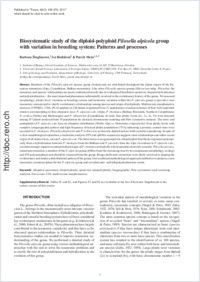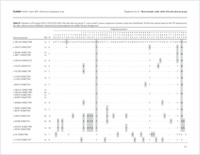Biosystematic study of the diploid-polyploid Pilosella alpicola group with variation in breeding system: Patterns and processes
- Šingliarová, Barbora Institute of Botany, Slovak Academy of Sciences, Bratislava, Slovakia
- Hodálová, Iva Institute of Botany, Slovak Academy of Sciences, Bratislava, Slovakia
- Mráz, Patrik Institute of Botany, Slovak Academy of Sciences, Bratislava, Slovakia - Université Joseph Fourier, Laboratoire d'Ecologie Alpine, Grenoble, France - Unit of Ecology and Evolution, Department of Biologie, University of Fribourg, Switzerland
-
2011
Published in:
- Taxon. - 2011, vol. 60, no. 2, p. 450-470
Allopatric speciation
Allopolyploidy
Apomixis
Autopolyploidy
Biogeography
Flow cytometric seed screening
Analysis
Hieracium
its
Multivariate morphometrics
English
Members of the Pilosella alpicola species group (Asteraceae) are distributed throughout the alpine region of the European mountains (Alps, Carpathians, Balkan mountains). Like other Pilosella species groups (Hieracium subg. Pilosella ), the taxonomy and species' relationships are poorly understood mostly due to widespread facultative apomixis, frequent hybridization and polyploidization—the most important phenomena substantially involved in the evolutionary history of the genus. We assessed morphology, ploidy level, variation in breeding system and molecular variation within the P. alpicola group to provide a new taxonomic concept and to clarify evolutionary relationships among species and origin of polyploids. Multivariate morphometric analyses (UPGMA, CDA, PCA) applied on 324 plants originated from 21 populations revealed existence of four well-separated clusters corresponding to four allopatric taxa: P. alpicola s. str. (Alps), P. rhodopea (Balkan Peninsula, Southern Carpathians), P. serbica (Serbia and Montenegro) and P. ullepitschii (Carpathians). In total, four ploidy levels (2 x, 3 x, 4 x, 5 x ) were detected among 557 plants analysed from 19 populations by classical chromosome counting and flow cytometric analysis. The tetra- and pentaploids of P. alpicola s. str. have an allopatric distribution (Wallis Alps vs. Dolomites, respectively). Four ploidy levels with complex cytogeographic pattern and high frequency of mixed ploidy populations (75%) indicating a primary contact zone were recorded inP. rhodopea. Pilosella ullepitschii andP. serbica are exclusively diploid and are both sexually reproducing. In spite of a clear morphological separation, a molecular analysis (ITS and cpDNA sequences) suggests close relationships and rather recent origin of all studied taxa, except P. alpicola s. str. The latter taxon is an agamospermic allopolyploid that likely originated polytopi cally from a hybridization between P. rhodopea from the Balkans and P. glacialis from the Alps. In contrast to P. alpicola s. str., our data strongly support an autopolyploid origin of P. rhodopea polyploids which reproduced strictly sexually. Pilosella petraea , sometimes treated as a member of the P. alpicola group, differs from the remaining taxa by its conspicuous morphology, ecology and ITS polymorphism and should be removed from the group. Range shifts and extinctions were likely involved in shaping the evolutionary and modern distributional pattern of the group. Our combined methodological approach enabled us to propose a new taxonomic circumscription for the P. alpicola group and revealed auto- and allopolyploidization events.
- Faculty
- Faculté des sciences et de médecine
- Department
- Département de Biologie
- Language
-
- English
- Classification
- Biological sciences
- License
- License undefined
- Identifiers
-
- RERO DOC 28389
- DOI 10.1002/tax.602014
- Persistent URL
- https://folia.unifr.ch/unifr/documents/302340
Other files
Statistics
Document views: 61
File downloads:
- mra_bsd.pdf: 281
- mra_bsd_sm.pdf: 99

